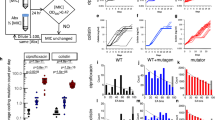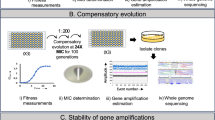Abstract
Reversing the evolution of traits harmful to humans, such as antimicrobial resistance, is a key ambition of applied evolutionary biology. A major impediment to reverse evolution is the relatively low spontaneous mutation rates that revert evolved genotypes back to their ancestral state. However, the repeated re-introduction of ancestral alleles by horizontal gene transfer (HGT) could make reverse evolution likely. Here we evolve populations of an antibiotic-resistant strain of Helicobacter pylori in growth conditions without antibiotics while introducing an ancestral antibiotic-sensitive allele by HGT. We evaluate reverse evolution using DNA sequencing and find that HGT facilitates the molecular reverse evolution of the antibiotic resistance allele, and that selection for high rates of HGT drives the evolution of increased HGT rates in low-HGT treatment populations. Finally, we use a theoretical model and carry out simulations to infer how the fitness costs of antibiotic resistance, rates of HGT and effects of genetic drift interact to determine the probability and predictability of reverse evolution.
This is a preview of subscription content, access via your institution
Access options
Access Nature and 54 other Nature Portfolio journals
Get Nature+, our best-value online-access subscription
$29.99 / 30 days
cancel any time
Subscribe to this journal
Receive 12 digital issues and online access to articles
$119.00 per year
only $9.92 per issue
Buy this article
- Purchase on Springer Link
- Instant access to full article PDF
Prices may be subject to local taxes which are calculated during checkout




Similar content being viewed by others
Data availability
All data used in this study are available in the supplementary information, and raw sequencing reads have been deposited in GenBank under Bioproject ID: PRJNA907068.
References
Bull, J. J. & Charnov, E. L. On irreversible evolution. Evolution 39, 1149–1155 (1985).
Bridgham, J. T., Ortlund, E. A. & Thornton, J. W. An epistatic ratchet constrains the direction of glucocorticoid receptor evolution. Nature 461, 515–519 (2009).
Debray, R., De Luna, N. & Koskella, B. Historical contingency drives compensatory evolution and rare reversal of phage resistance. Mol. Biol. Evol. https://doi.org/10.1093/molbev/msac182 (2022).
Ogbunugafor, C. B. & Hartl, D. A pivot mutation impedes reverse evolution across an adaptive landscape for drug resistance in Plasmodium vivax. Malar. J. 15, 40 (2016).
Bjorkholm, B. et al. Mutation frequency and biological cost of antibiotic resistance in Helicobacter pylori. Proc. Natl Acad. Sci. USA 98, 14607–14612 (2001).
Nagaev, I., Bjorkman, J., Andersson, D. I. & Hughes, D. Biological cost and compensatory evolution in fusidic acid-resistant Staphylococcus aureus. Mol. Microbiol. 40, 433–439 (2001).
Gagneux, S. et al. The competitive cost of antibiotic resistance in Mycobacterium tuberculosis. Science 312, 1944–1946 (2006).
Rozen, D. E., McGee, L., Levin, B. R. & Klugman, K. P. Fitness costs of fluoroquinolone resistance in Streptococcus pneumoniae. Antimicrob. Agents Chemother. 51, 412–416 (2007).
Beceiro, A. et al. Biological cost of different mechanisms of colistin resistance and their impact on virulence in Acinetobacter baumannii. Antimicrob. Agents Chemother. 58, 518–526 (2014).
Melnyk, A. H., Wong, A. & Kassen, R. The fitness costs of antibiotic resistance mutations. Evol. Appl. 8, 273–283 (2015).
Nang, S. C. et al. Fitness cost of mcr-1-mediated polymyxin resistance in Klebsiella pneumoniae. J. Antimicrob. Chemother. 73, 1604–1610 (2018).
Levin, B. R., Perrot, V. & Walker, N. Compensatory mutations, antibiotic resistance and the population genetics of adaptive evolution in bacteria. Genetics 154, 985–997 (2000).
Moore, F. B. G., Rozen, D. E. & Lenski, R. E. Pervasive compensatory adaptation in Escherichia coli. Proc. R. Soc. Lond. B 267, 515–522 (2000).
San Millan, A. et al. Positive selection and compensatory adaptation interact to stabilize non-transmissible plasmids. Nat. Commun. 5, 5208 (2014).
Loftie-Eaton, W. et al. Compensatory mutations improve general permissiveness to antibiotic resistance plasmids. Nat. Ecol. Evol. 1, 1354–1363 (2017).
Dunai, A. et al. Rapid decline of bacterial drug-resistance in an antibiotic-free environment through phenotypic reversion. eLife https://doi.org/10.7554/eLife.47088 (2019).
Hernando-Amado, S., Laborda, P., Valverde, J. R. & Martinez, J. L. Rapid decline of ceftazidime resistance in antibiotic-free and sublethal environments is contingent on genetic background. Mol. Biol. Evol. 39, msac049 (2022).
Santos-Lopez, A. et al. The roles of history, chance, and natural selection in the evolution of antibiotic resistance. eLife 10, e70676 (2021).
Pennings, P. S., Ogbunugafor, C. B. & Hershberg, R. Reversion is most likely under high mutation supply when compensatory mutations do not fully restore fitness costs. G3 12, jkac190 (2022).
Woods, L. C. et al. Horizontal gene transfer potentiates adaptation by reducing selective constraints on the spread of genetic variation. Proc. Natl Acad. Sci. USA https://doi.org/10.1073/pnas.2005331117 (2020).
Nguyen, A. N. T. et al. Recombination resolves the cost of horizontal gene transfer in experimental populations of Helicobacter pylori. Proc. Natl Acad. Sci. USA 119, e2119010119 (2022).
Pletz, M. W. et al. Fluoroquinolone resistance in invasive Streptococcus pyogenes isolates due to spontaneous mutation and horizontal gene transfer. Antimicrob. Agents Chemother. 50, 943–948 (2006).
Duesberg, C. B. et al. Interspecies recombination occurs frequently in quinolone resistance-determining regions of clinical isolates of Streptococcus pyogenes. Antimicrob. Agents Chemother. 52, 4191–4193 (2008).
Teotonio, H. & Rose, M. R. Perspective: reverse evolution. Evolution 55, 653–660 (2001).
Arnold, B. J., Huang, I. T. & Hanage, W. P. Horizontal gene transfer and adaptive evolution in bacteria. Nat. Rev. Microbiol. 20, 206–218 (2022).
Stevenson, C., Hall, J. P., Harrison, E., Wood, A. & Brockhurst, M. A. Gene mobility promotes the spread of resistance in bacterial populations. ISME J. 11, 1930–1932 (2017).
Maddamsetti, R. & Lenski, R. E. Analysis of bacterial genomes from an evolution experiment with horizontal gene transfer shows that recombination can sometimes overwhelm selection. PLoS Genet. 14, e1007199 (2018).
Liu, Z. Q., Zheng, P. Y. & Yang, P. C. Efflux pump gene hefA of Helicobacter pylori plays an important role in multidrug resistance. World J. Gastroenterol. 14, 5217–5222 (2008).
Ando, T. et al. Restriction-modification system differences in Helicobacter pylori are a barrier to interstrain plasmid transfer. Mol. Microbiol. 37, 1052–1065 (2000).
Bubendorfer, S. et al. Genome-wide analysis of chromosomal import patterns after natural transformation of Helicobacter pylori. Nat. Commun. 7, 11995 (2016).
Cooper, T. F., Remold, S. K., Lenski, R. E. & Schneider, D. Expression profiles reveal parallel evolution of epistatic interactions involving the CRP regulon in Escherichia coli. PLoS Genet. https://doi.org/10.1371/Journal.Pgen.0040035 (2008).
Wong, A. & Kassen, R. Parallel evolution and local differentiation in quinolone resistance in Pseudomonas aeruginosa. Microbiology 157, 937–944 (2011).
Herron, M. D. & Doebeli, M. Parallel evolutionary dynamics of adaptive diversification in Escherichia coli. PLoS Biol. 11, e1001490 (2013).
Leu, J. Y., Chang, S. L., Chao, J. C., Woods, L. C. & McDonald, M. J. Sex alters molecular evolution in diploid experimental populations of S. cerevisiae. Nat. Ecol. Evol. https://doi.org/10.1038/s41559-020-1101-1 (2020).
Tenaillon, O. et al. The molecular diversity of adaptive convergence. Science 335, 457–461 (2012).
Lang, G. I. et al. Pervasive genetic hitchhiking and clonal interference in forty evolving yeast populations. Nature 500, 571–574 (2013).
Good, B. H., McDonald, M. J., Barrick, J. E., Lenski, R. E. & Desai, M. M. The dynamics of molecular evolution over 60,000 generations. Nature 551, 45–50 (2017).
Venkataram, S. et al. Development of a comprehensive genotype-to-fitness map of adaptation-driving mutations in yeast. Cell 166, 1585–1596.e22 (2016).
Hirata, K. et al. Contribution of efflux pumps to clarithromycin resistance in Helicobacter pylori. J. Gastroenterol. Hepatol. 25, S75–S79 (2010).
Sniegowski, P. D., Gerrish, P. J. & Lenski, R. E. Evolution of high mutation rates in experimental populations of E. coli. Nature 387, 703–705 (1997).
Pal, C., Macia, M. D., Oliver, A., Schachar, I. & Buckling, A. Coevolution with viruses drives the evolution of bacterial mutation rates. Nature 450, 1079–1081 (2007).
Wielgoss, S. et al. Mutation rate dynamics in a bacterial population reflect tension between adaptation and genetic load. Proc. Natl Acad. Sci. USA 110, 222–227 (2013).
McDonald, M. J., Hsieh, Y. Y., Yu, Y. H., Chang, S. L. & Leu, J. Y. The evolution of low mutation rates in experimental mutator populations of Saccharomyces cerevisiae. Curr. Biol. 22, 1235–1240 (2012).
Ortiz-Barrientos, D., Engelstadter, J. & Rieseberg, L. H. Recombination rate evolution and the origin of species. Trends Ecol. Evol. 31, 226–236 (2016).
Winbush, A. & Singh, N. D. Variation in fine-scale recombination rate in temperature-evolved Drosophila melanogaster populations in response to selection. G3 https://doi.org/10.1093/g3journal/jkac208 (2022).
Humbert, O., Dorer, M. S. & Salama, N. R. Characterization of Helicobacter pylori factors that control transformation frequency and integration length during inter-strain DNA recombination. Mol. Microbiol. 79, 387–401 (2011).
Vogwill, T. & MacLean, R. C. The genetic basis of the fitness costs of antimicrobial resistance: a meta-analysis approach. Evol. Appl. 8, 284–295 (2015).
Carr, I. M. et al. Inferring relative proportions of DNA variants from sequencing electropherograms. Bioinformatics 25, 3244–3250 (2009).
Deatherage, D. E. & Barrick, J. E. Identification of mutations in laboratory-evolved microbes from next-generation sequencing data using breseq. Methods Mol. Biol. 1151, 165–188 (2014).
Wick, R. R., Judd, L. M., Gorrie, C. L. & Holt, K. E. Unicycler: resolving bacterial genome assemblies from short and long sequencing reads. PLoS Comput. Biol. 13, e1005595 (2017).
Seemann, T. Prokka: rapid prokaryotic genome annotation. Bioinformatics 30, 2068–2069 (2014).
Page, A. J. et al. Roary: rapid large-scale prokaryote pan genome analysis. Bioinformatics 31, 3691–3693 (2015).
Stecher, G., Tamura, K. & Kumar, S. Molecular Evolutionary Genetics Analysis (MEGA) for macOS. Mol. Biol. Evol. 37, 1237–1239 (2020).
Charlesworth, B. & Charlesworth, D. Elements of Evolutionary Genetics (Roberts and Company, 2010).
R Core Team. R: A Language and Environment for Statistical Computing (R Foundation for Statistical Computing, 2022).
Acknowledgements
M.J.M. was financially supported by an ARC Discovery Grant (DP220103548) and an NHMRC ideas grant (APP1186140).
Author information
Authors and Affiliations
Contributions
M.J.M. conceived the experiment; A.N.T.N., R.G., T.K. and M.J.M. designed experiments; A.N.T.N. performed experiments; A.N.T.N. carried out sequencing and data analysis; T.C. developed the theory; T.C. and A.N.T.N. performed simulations; A.N.T.N., T.C. and M.J.M. carried out data visualization. All authors wrote the paper.
Corresponding authors
Ethics declarations
Competing interests
The authors declare no competing interests.
Peer review
Peer review information
Nature Ecology & Evolution thanks the anonymous reviewers for their contribution to the peer review of this work.
Additional information
Publisher’s note Springer Nature remains neutral with regard to jurisdictional claims in published maps and institutional affiliations.
Extended data
Extended Data Fig. 1 Replicate transformation efficiency assays.
Transformation efficiency assays for CH426 (purple) and gene deletion mutants for mod3(turquoise) and mod5 (yellow). The assay was repeated three times (N = 3 biologically independent replicates) to account for day and plating effects (A-C). Each coloured dot is an independent plating count for a replicate transformation experiment, empty circles show the mean. Lower bound for the confidence interval not shown where it cannot fit onto the log scale due to being very small, or less than zero.
Extended Data Fig. 2 Accepted parameter values for Approximate Bayesian rejection sampling.
For simulations of a Wright-Fisher model with transformation, selection and drift (grey circles: n = 500 accepted parameter combinations). The black circles and whiskers show the mean and 95% confidence intervals for the two parameters in the accepted parameter sets. The parameter \(\gamma\) denotes the transformation rate relevant to CH428 populations.
Supplementary information
Supplementary Data 1
Supplementary Tables 1–8 with raw data and reporting on statistical tests.
Rights and permissions
Springer Nature or its licensor (e.g. a society or other partner) holds exclusive rights to this article under a publishing agreement with the author(s) or other rightsholder(s); author self-archiving of the accepted manuscript version of this article is solely governed by the terms of such publishing agreement and applicable law.
About this article
Cite this article
Nguyen, A.N.T., Gorrell, R., Kwok, T. et al. Horizontal gene transfer facilitates the molecular reverse-evolution of antibiotic sensitivity in experimental populations of H. pylori. Nat Ecol Evol 8, 315–324 (2024). https://doi.org/10.1038/s41559-023-02269-5
Received:
Accepted:
Published:
Issue Date:
DOI: https://doi.org/10.1038/s41559-023-02269-5



